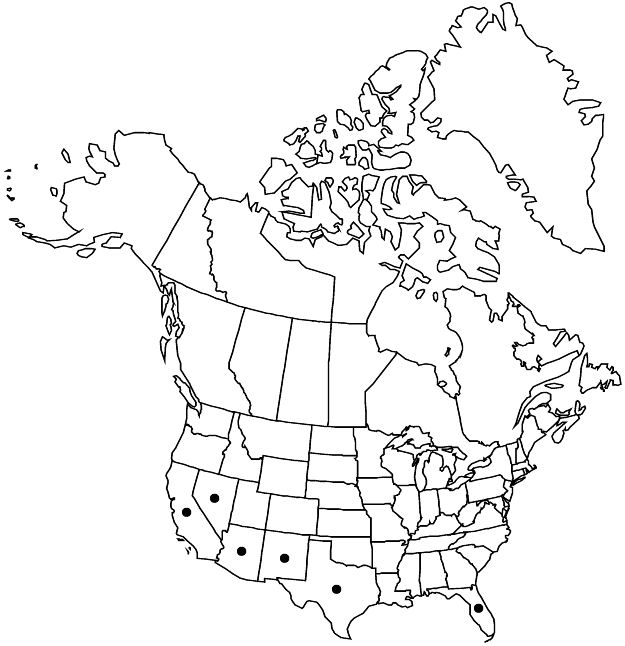Citrullus afer
Linnaea 12: 413. 1838 (as caffer).
Vines annual. Stems climbing or trailing, 50–200 cm, villous; roots fibrous; tendrils 2–3-branched. Leaf blades ovate, 3–5-lobed, 3–8 cm, lobes pinnately shallowly sinuate-lobulate, margins denticulate, surfaces hirsute abaxially, hispid on veins and veinlets, glabrous or scabrous adaxially with translucent dots. Flowers: hypanthium broadly campanulate; sepals lanceolate, 3–5 mm; petals obovate-oblong to widely oblanceolate, 7–16 mm. Pepos green, mottled with paler green and yellowish to whitish stripes, globose to globose-ovoid, 15–25 cm diam.; rind tough, durable, mesocarp whitish, dry, bitter. Seeds tan or greenish, ovoid to oblong-ovoid, 7–15 mm. 2n = 22.
Phenology: Flowering Jun–Oct(–Nov).
Habitat: Sandy fields, pinelands, cotton fields, orange groves, roadsides, railroad banks and tracks, disturbed sites
Elevation: 50–500 m
Distribution

Introduced; Ariz., Calif., Fla., Nev., N.Mex., Tex., Africa, introduced also in West Indies.
Discussion
Records for Citrullus afer outside of cultivation in the flora area are scattered and uncommon. It is called preserving melon because the fruit rind and white flesh are candied or pickled and used in preserves and jellies.
Molecular studies have shown that the cultivated watermelon (Citrullus lanatus) and the citron melon represent closely related but distinct lineages (F. Dane and P. Lang 2004; Dane and J. Liu 2007; A. Levi and C. E. Thomas 2005). The two taxa have distinct haplotypes and appear to have evolved from a common ancestor perhaps closely similar to C. ecirrhosus. The evolutionary divergence is estimated to have occurred between 0.6 and 0.9 million years ago, long before selection by humans.
Three cpDNA haplotypes exist among the citron melon and the wild tsamma melon of the Kalahari Desert (F. Dane and J. Liu 2007). These three entities apparently have not been unambiguously recognized by formal nomenclature, or at least the genetic affinities of names potentially associated with these haplotypes are not known. The ancestral citron haplotype is known from Swaziland and South Africa; each of the other two ranges across southern Africa. A number of distinct landraces that are cultivated in the Kalahari region (including the tsamma melons) may represent early forms of domestication, as suggested by G. Maggs-Kolling et al. (2000).
Selected References
None.